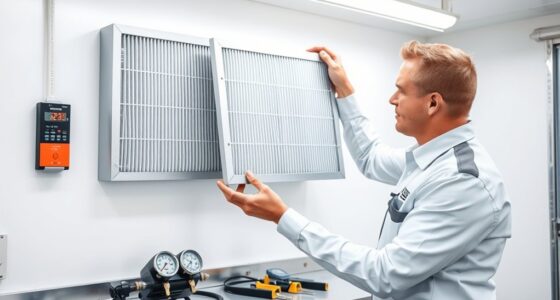From the ground, you can spot uneven or missing shingles, look for debris or granules in gutters, and check for stains or dark streaks that might signal algae or mold. Shine a flashlight inside the attic to see if light leaks through, indicating gaps. Pay attention to sagging gutters or signs of water damage beneath the eaves. Keep an eye out for any obvious damage—if you want to learn more, you’ll find helpful tips to inspect your roof effectively.
Key Takeaways
- Observe the overall roof shape and shingles for unevenness, damage, or missing sections using binoculars if needed.
- Check gutters and downspouts for debris, shingle granules, or signs of clogging that indicate roof wear.
- Look for dark streaks, stains, or moss on the roof surface suggesting algae, mold, or water pooling issues.
- Inspect for sagging areas or dips that may signal support or water damage from the ground view.
- Examine the ground beneath the roof for granules, moss, or debris that could point to roofing deterioration.

Have you ever wondered how to assess your roof’s condition without climbing up? It’s a smart question, especially if you’re wary of heights or if the weather isn’t cooperating. Fortunately, there are several effective ways to inspect your roof from the ground, giving you valuable insights without risking a dangerous climb. The key is to use your eyes and some common tools to identify signs of trouble early, so you can plan repairs or maintenance before minor issues become major repairs.
Start by taking a good look at your roof from different angles. Stand back and observe the overall shape and structure. Look for any sections where the shingles seem uneven, curling, or missing entirely. Pay close attention to areas around vents, chimneys, and skylights, as these are common spots for leaks or damage. If you notice any sagging or dips, it could indicate underlying problems with your roof’s support system or water damage. Use binoculars if you need a closer look but can’t get too close without risking safety. With a good pair of binoculars, you can spot issues like broken or missing shingles, damaged flashing, or debris accumulation.
Next, check the gutters and downspouts from the ground. Clogged gutters often signal that your roof might have debris buildup, which can trap moisture and lead to rot. Look for shingle granules in the gutter—these tiny particles can wash off when shingles wear out, revealing that your roof may be nearing the end of its lifespan. Also, examine the ground below your roofline for signs of shingle granules, moss, or algae, which can suggest aging or moss growth that might compromise your roofing material.
Another way to assess your roof from the ground is to look for streaks, stains, or discoloration on the shingles. Dark streaks can indicate algae or mold, which thrive in moist environments and can weaken your roof over time. Yellow or black stains might also point to water pooling or leaks. If you spot any of these, it’s wise to schedule an inspection with a roofing professional. Regular ground-level inspections can also help you notice practical support signs of damage early, allowing for timely maintenance.
Finally, pay attention to your attic if you have access. Check for light coming through the rafters or signs of water stains, mold, or rot. Even if you’re inspecting from outside, these signs can help confirm your suspicions and guide your next steps. By regularly doing these ground-level checks, you can catch potential issues early, saving you money and stress in the long run. Staying vigilant from the ground keeps you informed about your roof’s health without risking your safety.
Frequently Asked Questions
Can I Safely Inspect My Roof From the Ground?
Yes, you can safely inspect your roof from the ground, but only if you follow proper precautions. Use binoculars to get a closer look at shingles, flashing, and gutters. Avoid climbing ladders or walking on the roof unless you’re trained and equipped. Keep your distance, especially in bad weather or if the roof looks damaged or unstable. When in doubt, hire a professional to guarantee safety and thorough inspection.
What Tools Are Best for Ground-Level Roof Inspections?
Think of a sturdy pair of binoculars as your modern spyglass, ideal for ground-level roof inspections. You’ll want a good pair with a wide field of view to spot missing shingles, moss, or damage. A camera or smartphone with a zoom lens also helps document issues from a safe distance. Use a ladder with stabilizers for closer looks, but always prioritize safety and avoid climbing onto the roof itself.
How Often Should I Perform Ground-Based Roof Checks?
You should perform ground-based roof checks at least twice a year, ideally in spring and fall, to catch any damage early. After severe weather events like storms or strong winds, check more frequently. Regular inspections help you spot missing shingles, debris buildup, or damage before it worsens. Staying proactive guarantees your roof stays in good shape and prevents costly repairs down the line.
What Signs Indicate a Roof Needs Professional Repair?
If you notice missing or damaged shingles, excessive granule loss in gutters, curling or buckling roofing materials, or dark streaks and moss, your roof likely needs professional repair. Also, look for leaks inside your home, water stains, or sagging areas on the roof surface. These signs indicate underlying issues that require expert assessment and repairs to prevent further damage and guarantee your roof’s integrity.
Are Ground Inspections Effective for All Roof Types?
Ground inspections can be effective for many roof types, especially asphalt shingles and metal roofs, but they might not catch every issue. You should look for visible damage like missing shingles, sagging, or debris accumulation. However, for more complex roof structures, flat roofs, or areas with limited visibility, it’s best to have a professional inspection. Don’t rely solely on ground checks; routine professional assessments guarantee thorough maintenance.
Conclusion
Now that you know how to inspect your roof from the ground, you’re like a vigilant guardian watching over your home’s crown. With a keen eye and steady gaze, you can catch trouble before it takes hold, keeping your sanctuary safe and sound. Think of these checks as your shield—quiet, reliable, always ready. By staying attentive, you’re not just maintaining a roof; you’re nurturing a fortress of memories and love beneath its protective embrace.









